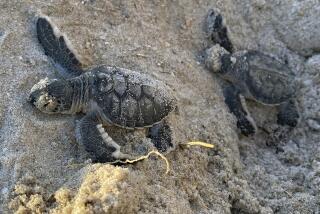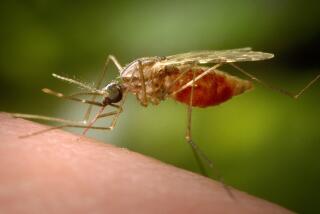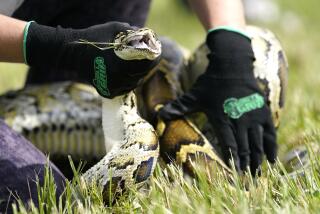South Florida’s heat is key to boom of pythons and cold-blooded cousins
If Floridians ever want to rid the state of Burmese pythons, tegus and other slithery invaders, they should hope for cold.
A new University of Florida study has confirmed what scientists have long suspected: Temperature, more than habitat, determines where reptiles invade. Using the kind of risk assessment strategy normally used in business, researchers modeled where invasive lizards and geckos were likely to live based on native habits, and then compared that to where they live in Florida. Temperature creates an invisible barrier.
And that means South Florida is likely to remain the nation’s hottest spot for invasive species.
Scientists started thinking about the power of temperature after a severe 2010 cold snap froze iguanas and wiped out pythons in unprecedented numbers, said Frank Mazzotti, a biologist and one of the study’s five authors..
“That’s when people really began to appreciate that acute cold events may often be as important or more important than regular cold weather,” he said. “It’s not how cold it gets all the time. It’s how cold it gets when it really gets cold.”
To test their theory, researchers looked at the invasive reptiles on the Florida landscape. They then whittled down the list to include only reptiles that are well understood in their native ranges, which could provide enough data to feed into their models. Pythons, while a bigger threat, didn’t make the cut. Neither did tegus or Nile monitor lizards, two more-aggressive egg-eating, cat-consuming invaders.
Instead, they came up with 14 geckos, lizards and anoles, everyday invaders like the Hispaniola green anole and common wall gecko. They then compared their native ranges to their appearance in Florida.
The models showed that for reptiles, temperature matters most ��in particular, low temperatures. While temperature most accurately predicted location for the whole group, the type of land played a varying role depending on the species. Mediterranean house geckos were less picky about whether they lived in wetlands or a pine rockland. Star lizards were far more finicky, leading researchers to conclude that adding land type improves predictions.
Researchers also found that most exotics thrive in South Florida’s steamy tropics, which tend to more-closely match native ranges.
Being able to target likely hotspots could br a valuable tool in fighting the spread of invasive species that can destroy native wildlife and cost far more to remove once they become established, Mazzotti said.
“It helps us set our priority on where to look in South Florida,” he said.
(c)2015 Miami Herald
Visit Miami Herald at www.miamiherald.com
Distributed by Tribune Content Agency, LLC.
More to Read
Sign up for Essential California
The most important California stories and recommendations in your inbox every morning.
You may occasionally receive promotional content from the Los Angeles Times.










